Emirates Aviation University: Employee Turnover in Aviation Sector
VerifiedAdded on 2021/06/18
|20
|5890
|56
Project
AI Summary
This project, conducted by Maryam Fereidoun Far for a HND Business (Management) course at Emirates Aviation University, investigates the issue of employee turnover within the aviation industry. The research employs a mixed-methods approach, combining qualitative data from interviews with aviation industry managers and quantitative data from employee surveys. The study identifies key factors contributing to high turnover rates, including inadequate training, managerial challenges in supervising a large workforce, low wages, and a highly competitive job market. Thematic analysis of manager interviews reveals concerns about employee preparedness, communication gaps, and the impact of stress and competition. Survey results highlight the importance of monetary benefits, career growth opportunities, internal work culture, and management credibility. The analysis uses regression models to demonstrate the significant relationship between job satisfaction and factors such as recognition, workload, and firm culture. The project concludes by emphasizing the need for improved training, better management practices, and enhanced communication to address the challenges of employee retention within the aviation sector.
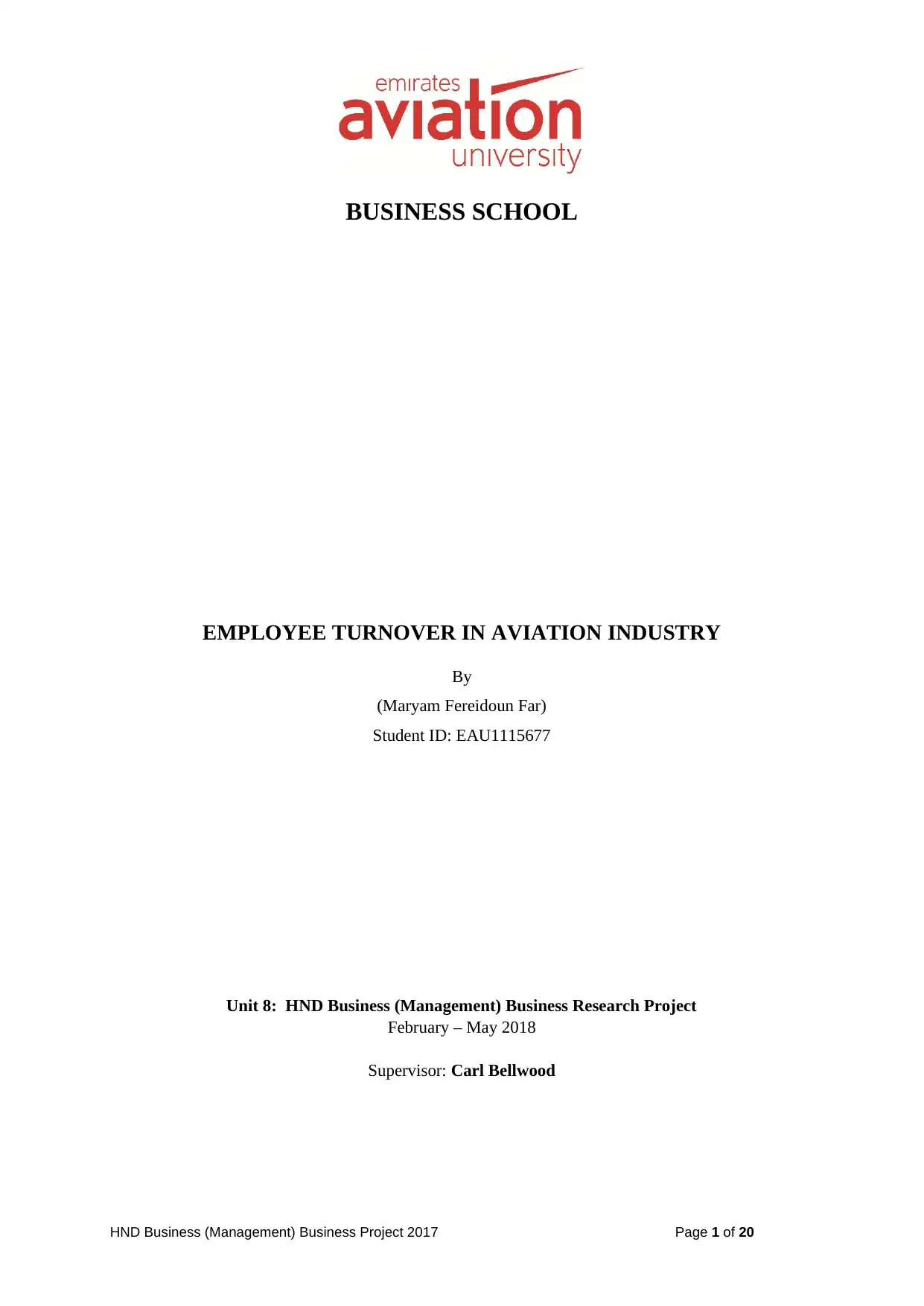
BUSINESS SCHOOL
EMPLOYEE TURNOVER IN AVIATION INDUSTRY
By
(Maryam Fereidoun Far)
Student ID: EAU1115677
Unit 8: HND Business (Management) Business Research Project
February – May 2018
Supervisor: Carl Bellwood
HND Business (Management) Business Project 2017 Page 1 of 20
EMPLOYEE TURNOVER IN AVIATION INDUSTRY
By
(Maryam Fereidoun Far)
Student ID: EAU1115677
Unit 8: HND Business (Management) Business Research Project
February – May 2018
Supervisor: Carl Bellwood
HND Business (Management) Business Project 2017 Page 1 of 20
Paraphrase This Document
Need a fresh take? Get an instant paraphrase of this document with our AI Paraphraser
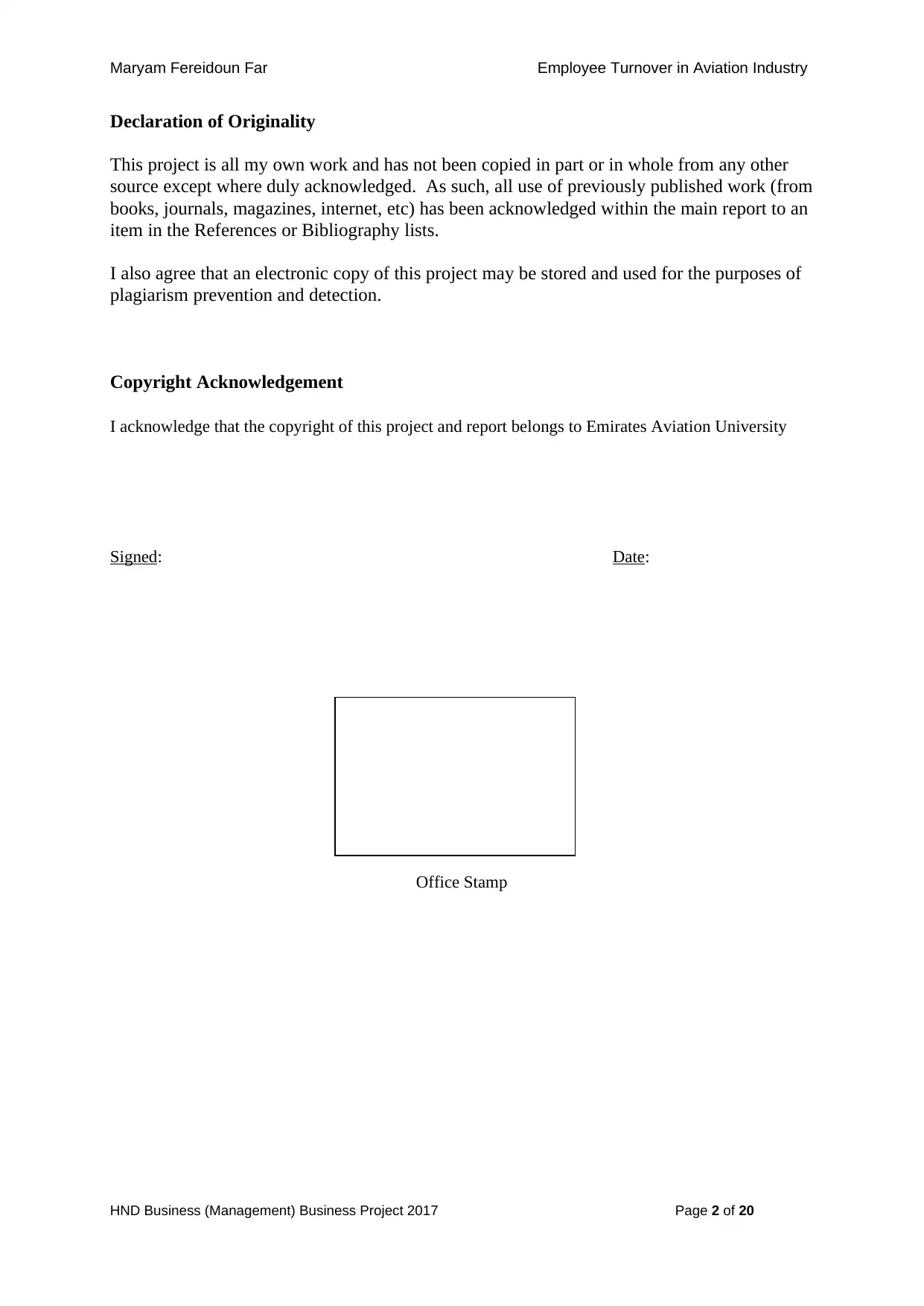
Maryam Fereidoun Far Employee Turnover in Aviation Industry
Declaration of Originality
This project is all my own work and has not been copied in part or in whole from any other
source except where duly acknowledged. As such, all use of previously published work (from
books, journals, magazines, internet, etc) has been acknowledged within the main report to an
item in the References or Bibliography lists.
I also agree that an electronic copy of this project may be stored and used for the purposes of
plagiarism prevention and detection.
Copyright Acknowledgement
I acknowledge that the copyright of this project and report belongs to Emirates Aviation University
Signed: Date:
Office Stamp
HND Business (Management) Business Project 2017 Page 2 of 20
Declaration of Originality
This project is all my own work and has not been copied in part or in whole from any other
source except where duly acknowledged. As such, all use of previously published work (from
books, journals, magazines, internet, etc) has been acknowledged within the main report to an
item in the References or Bibliography lists.
I also agree that an electronic copy of this project may be stored and used for the purposes of
plagiarism prevention and detection.
Copyright Acknowledgement
I acknowledge that the copyright of this project and report belongs to Emirates Aviation University
Signed: Date:
Office Stamp
HND Business (Management) Business Project 2017 Page 2 of 20
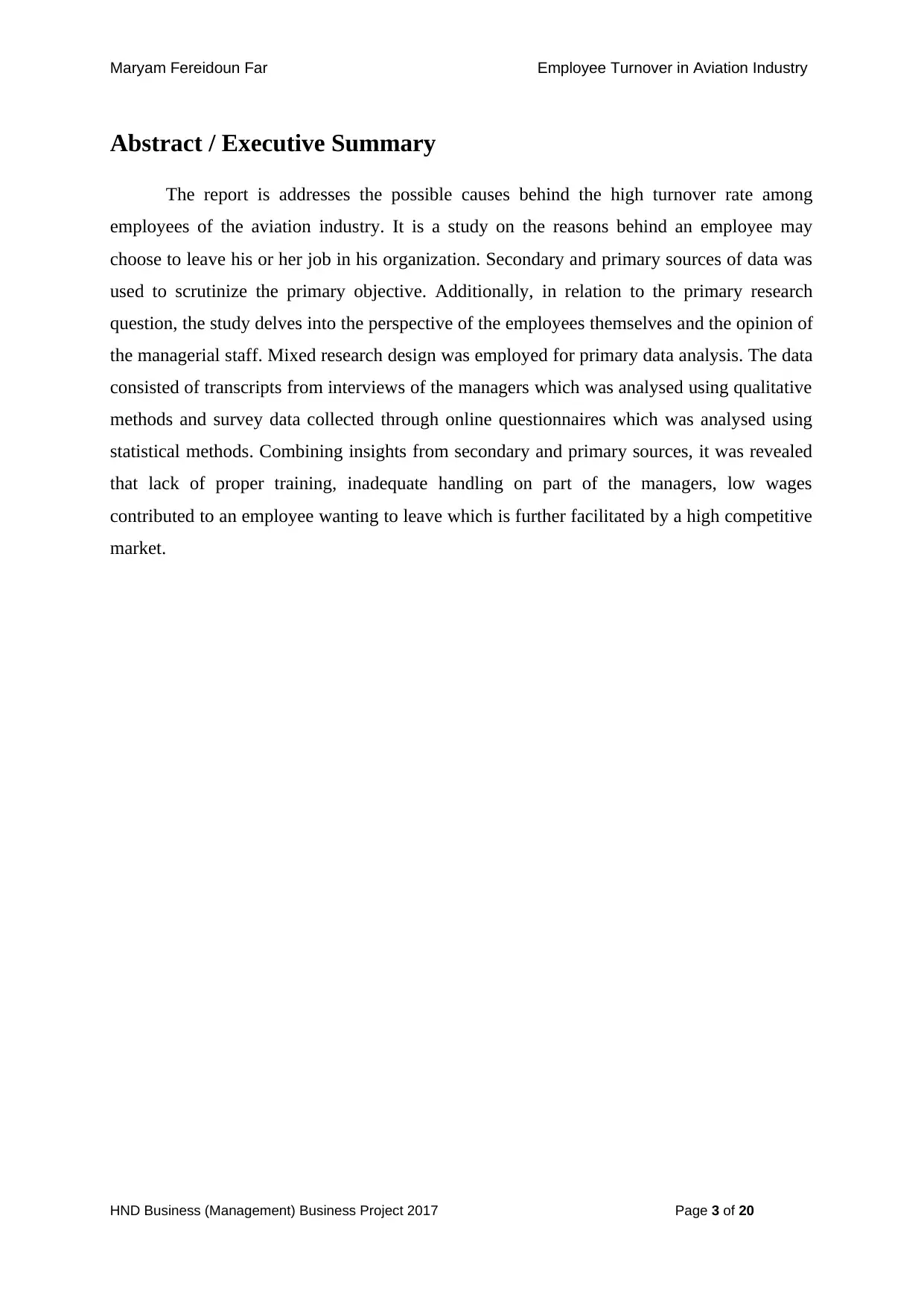
Maryam Fereidoun Far Employee Turnover in Aviation Industry
Abstract / Executive Summary
The report is addresses the possible causes behind the high turnover rate among
employees of the aviation industry. It is a study on the reasons behind an employee may
choose to leave his or her job in his organization. Secondary and primary sources of data was
used to scrutinize the primary objective. Additionally, in relation to the primary research
question, the study delves into the perspective of the employees themselves and the opinion of
the managerial staff. Mixed research design was employed for primary data analysis. The data
consisted of transcripts from interviews of the managers which was analysed using qualitative
methods and survey data collected through online questionnaires which was analysed using
statistical methods. Combining insights from secondary and primary sources, it was revealed
that lack of proper training, inadequate handling on part of the managers, low wages
contributed to an employee wanting to leave which is further facilitated by a high competitive
market.
HND Business (Management) Business Project 2017 Page 3 of 20
Abstract / Executive Summary
The report is addresses the possible causes behind the high turnover rate among
employees of the aviation industry. It is a study on the reasons behind an employee may
choose to leave his or her job in his organization. Secondary and primary sources of data was
used to scrutinize the primary objective. Additionally, in relation to the primary research
question, the study delves into the perspective of the employees themselves and the opinion of
the managerial staff. Mixed research design was employed for primary data analysis. The data
consisted of transcripts from interviews of the managers which was analysed using qualitative
methods and survey data collected through online questionnaires which was analysed using
statistical methods. Combining insights from secondary and primary sources, it was revealed
that lack of proper training, inadequate handling on part of the managers, low wages
contributed to an employee wanting to leave which is further facilitated by a high competitive
market.
HND Business (Management) Business Project 2017 Page 3 of 20
⊘ This is a preview!⊘
Do you want full access?
Subscribe today to unlock all pages.

Trusted by 1+ million students worldwide
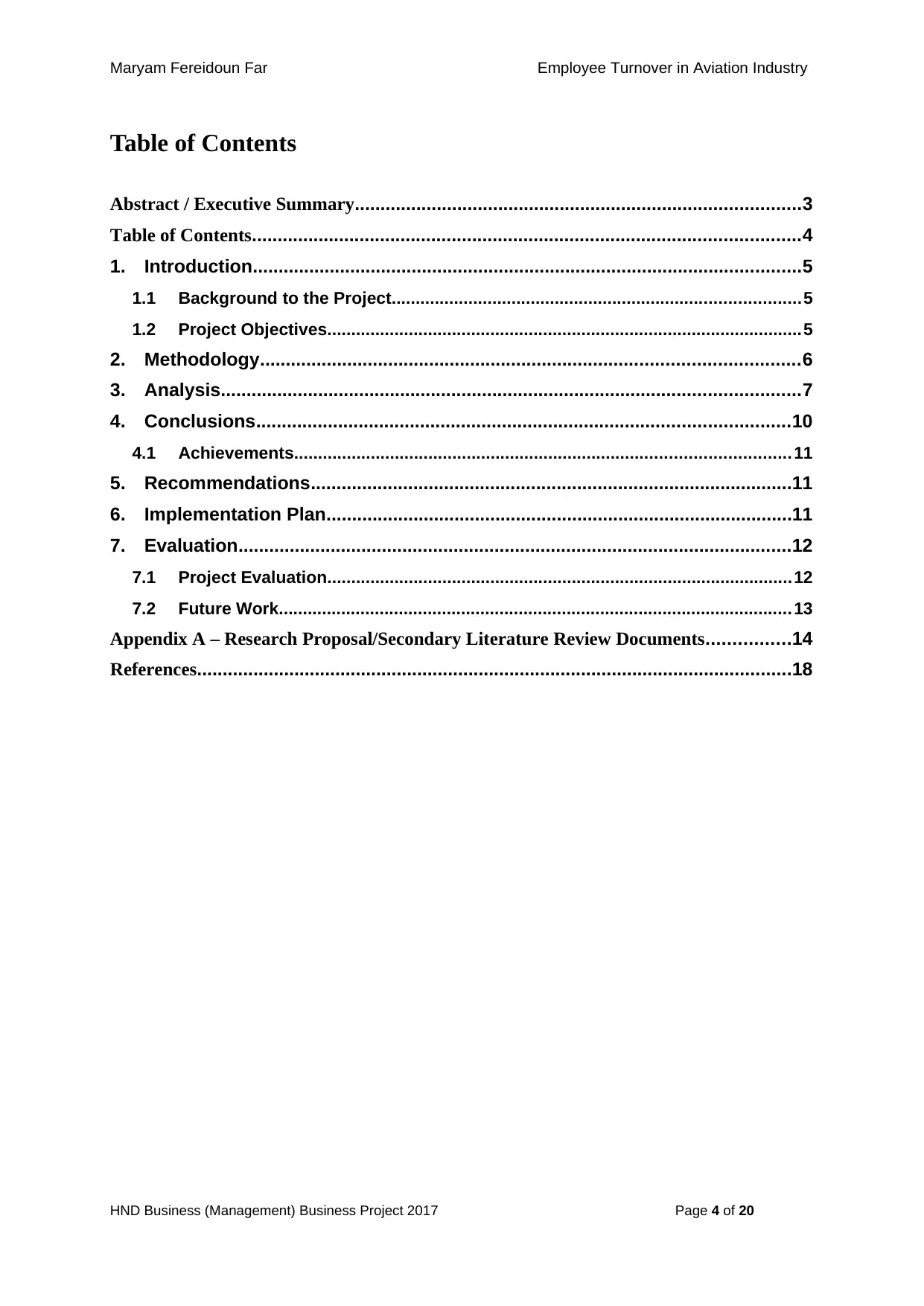
Maryam Fereidoun Far Employee Turnover in Aviation Industry
Table of Contents
Abstract / Executive Summary.......................................................................................3
Table of Contents...........................................................................................................4
1. Introduction...........................................................................................................5
1.1 Background to the Project.....................................................................................5
1.2 Project Objectives...................................................................................................5
2. Methodology.........................................................................................................6
3. Analysis.................................................................................................................7
4. Conclusions........................................................................................................10
4.1 Achievements.......................................................................................................11
5. Recommendations..............................................................................................11
6. Implementation Plan...........................................................................................11
7. Evaluation............................................................................................................12
7.1 Project Evaluation.................................................................................................12
7.2 Future Work...........................................................................................................13
Appendix A – Research Proposal/Secondary Literature Review Documents................14
References....................................................................................................................18
HND Business (Management) Business Project 2017 Page 4 of 20
Table of Contents
Abstract / Executive Summary.......................................................................................3
Table of Contents...........................................................................................................4
1. Introduction...........................................................................................................5
1.1 Background to the Project.....................................................................................5
1.2 Project Objectives...................................................................................................5
2. Methodology.........................................................................................................6
3. Analysis.................................................................................................................7
4. Conclusions........................................................................................................10
4.1 Achievements.......................................................................................................11
5. Recommendations..............................................................................................11
6. Implementation Plan...........................................................................................11
7. Evaluation............................................................................................................12
7.1 Project Evaluation.................................................................................................12
7.2 Future Work...........................................................................................................13
Appendix A – Research Proposal/Secondary Literature Review Documents................14
References....................................................................................................................18
HND Business (Management) Business Project 2017 Page 4 of 20
Paraphrase This Document
Need a fresh take? Get an instant paraphrase of this document with our AI Paraphraser
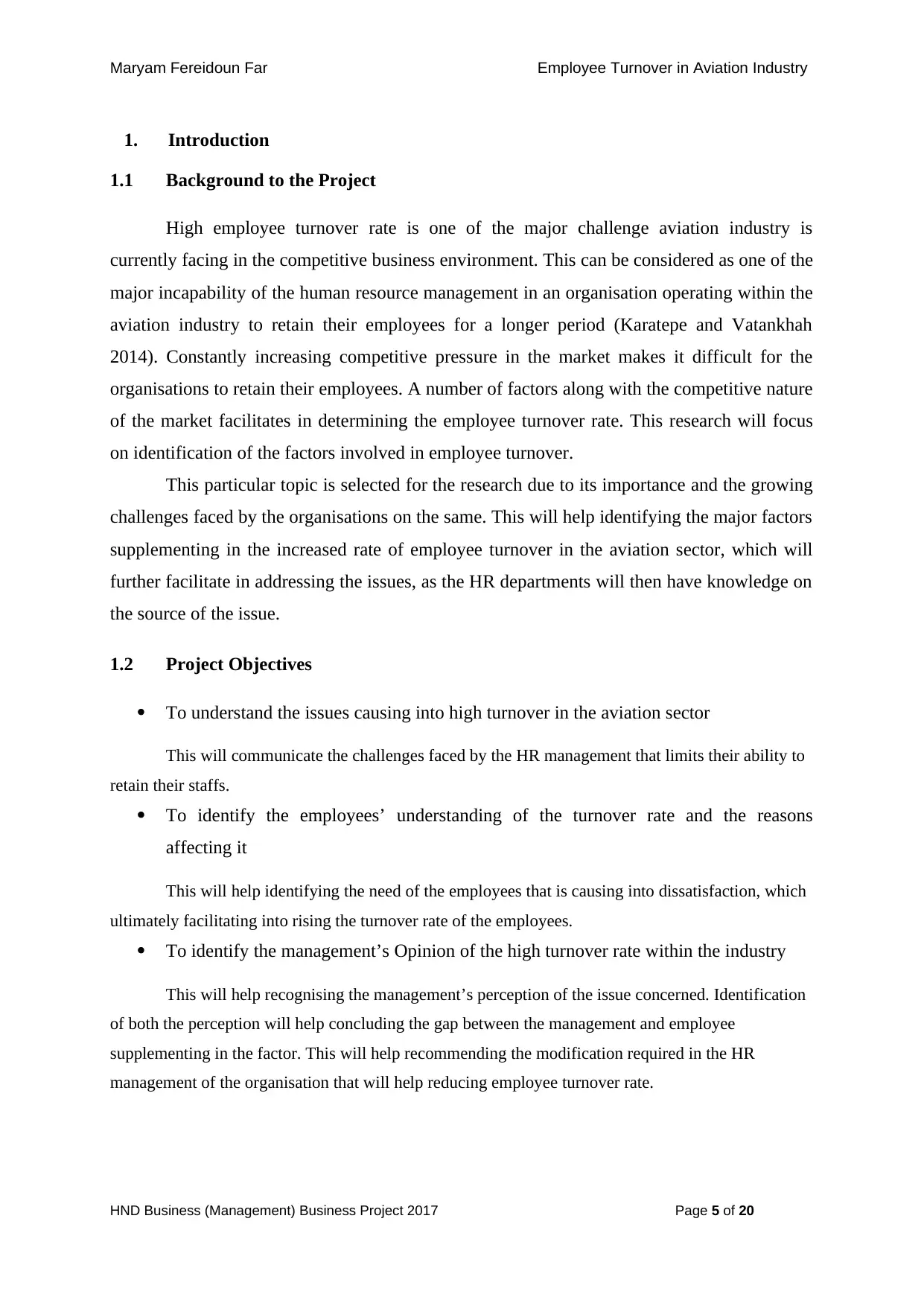
Maryam Fereidoun Far Employee Turnover in Aviation Industry
1. Introduction
1.1 Background to the Project
High employee turnover rate is one of the major challenge aviation industry is
currently facing in the competitive business environment. This can be considered as one of the
major incapability of the human resource management in an organisation operating within the
aviation industry to retain their employees for a longer period (Karatepe and Vatankhah
2014). Constantly increasing competitive pressure in the market makes it difficult for the
organisations to retain their employees. A number of factors along with the competitive nature
of the market facilitates in determining the employee turnover rate. This research will focus
on identification of the factors involved in employee turnover.
This particular topic is selected for the research due to its importance and the growing
challenges faced by the organisations on the same. This will help identifying the major factors
supplementing in the increased rate of employee turnover in the aviation sector, which will
further facilitate in addressing the issues, as the HR departments will then have knowledge on
the source of the issue.
1.2 Project Objectives
To understand the issues causing into high turnover in the aviation sector
This will communicate the challenges faced by the HR management that limits their ability to
retain their staffs.
To identify the employees’ understanding of the turnover rate and the reasons
affecting it
This will help identifying the need of the employees that is causing into dissatisfaction, which
ultimately facilitating into rising the turnover rate of the employees.
To identify the management’s Opinion of the high turnover rate within the industry
This will help recognising the management’s perception of the issue concerned. Identification
of both the perception will help concluding the gap between the management and employee
supplementing in the factor. This will help recommending the modification required in the HR
management of the organisation that will help reducing employee turnover rate.
HND Business (Management) Business Project 2017 Page 5 of 20
1. Introduction
1.1 Background to the Project
High employee turnover rate is one of the major challenge aviation industry is
currently facing in the competitive business environment. This can be considered as one of the
major incapability of the human resource management in an organisation operating within the
aviation industry to retain their employees for a longer period (Karatepe and Vatankhah
2014). Constantly increasing competitive pressure in the market makes it difficult for the
organisations to retain their employees. A number of factors along with the competitive nature
of the market facilitates in determining the employee turnover rate. This research will focus
on identification of the factors involved in employee turnover.
This particular topic is selected for the research due to its importance and the growing
challenges faced by the organisations on the same. This will help identifying the major factors
supplementing in the increased rate of employee turnover in the aviation sector, which will
further facilitate in addressing the issues, as the HR departments will then have knowledge on
the source of the issue.
1.2 Project Objectives
To understand the issues causing into high turnover in the aviation sector
This will communicate the challenges faced by the HR management that limits their ability to
retain their staffs.
To identify the employees’ understanding of the turnover rate and the reasons
affecting it
This will help identifying the need of the employees that is causing into dissatisfaction, which
ultimately facilitating into rising the turnover rate of the employees.
To identify the management’s Opinion of the high turnover rate within the industry
This will help recognising the management’s perception of the issue concerned. Identification
of both the perception will help concluding the gap between the management and employee
supplementing in the factor. This will help recommending the modification required in the HR
management of the organisation that will help reducing employee turnover rate.
HND Business (Management) Business Project 2017 Page 5 of 20
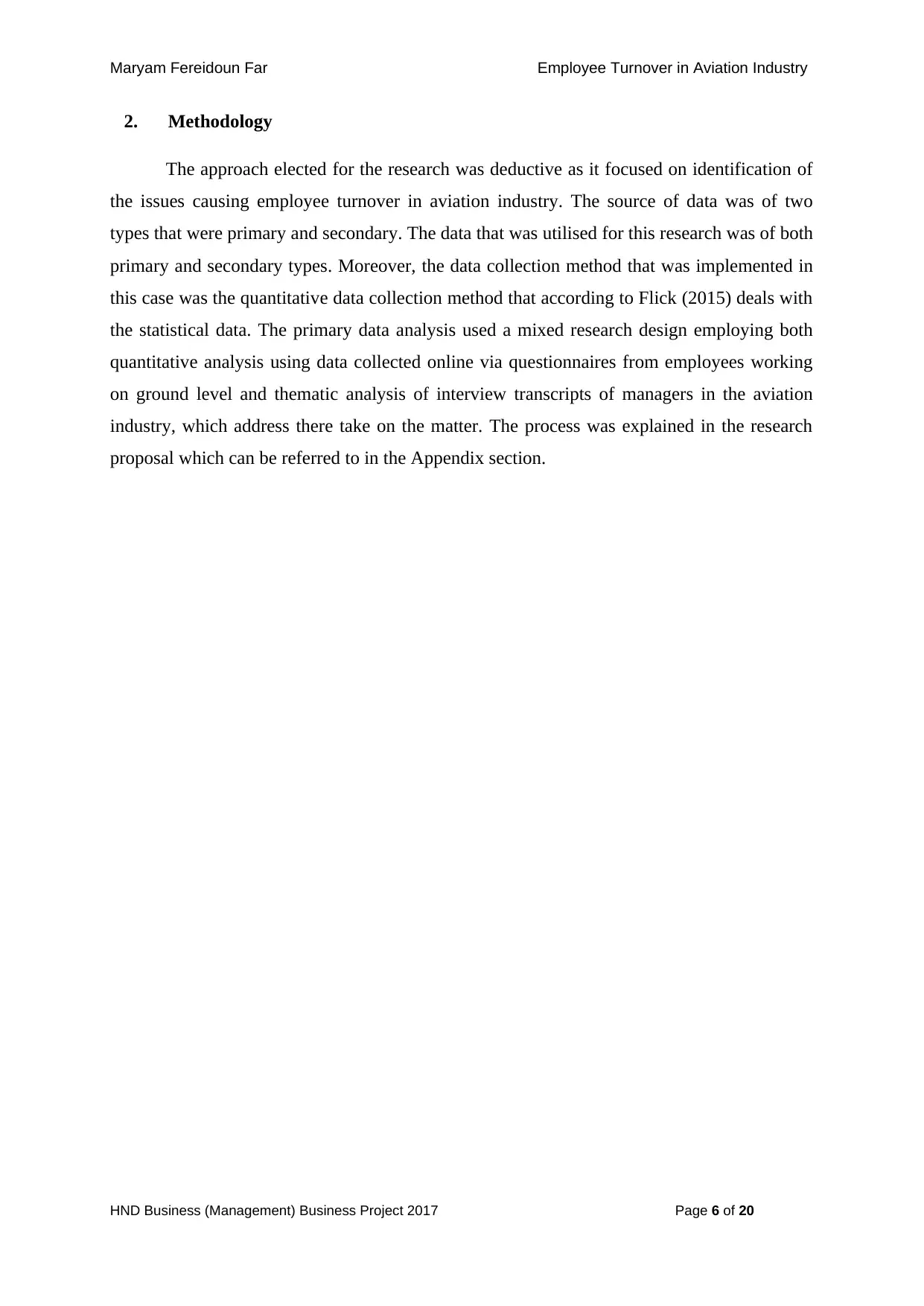
Maryam Fereidoun Far Employee Turnover in Aviation Industry
2. Methodology
The approach elected for the research was deductive as it focused on identification of
the issues causing employee turnover in aviation industry. The source of data was of two
types that were primary and secondary. The data that was utilised for this research was of both
primary and secondary types. Moreover, the data collection method that was implemented in
this case was the quantitative data collection method that according to Flick (2015) deals with
the statistical data. The primary data analysis used a mixed research design employing both
quantitative analysis using data collected online via questionnaires from employees working
on ground level and thematic analysis of interview transcripts of managers in the aviation
industry, which address there take on the matter. The process was explained in the research
proposal which can be referred to in the Appendix section.
HND Business (Management) Business Project 2017 Page 6 of 20
2. Methodology
The approach elected for the research was deductive as it focused on identification of
the issues causing employee turnover in aviation industry. The source of data was of two
types that were primary and secondary. The data that was utilised for this research was of both
primary and secondary types. Moreover, the data collection method that was implemented in
this case was the quantitative data collection method that according to Flick (2015) deals with
the statistical data. The primary data analysis used a mixed research design employing both
quantitative analysis using data collected online via questionnaires from employees working
on ground level and thematic analysis of interview transcripts of managers in the aviation
industry, which address there take on the matter. The process was explained in the research
proposal which can be referred to in the Appendix section.
HND Business (Management) Business Project 2017 Page 6 of 20
⊘ This is a preview!⊘
Do you want full access?
Subscribe today to unlock all pages.

Trusted by 1+ million students worldwide
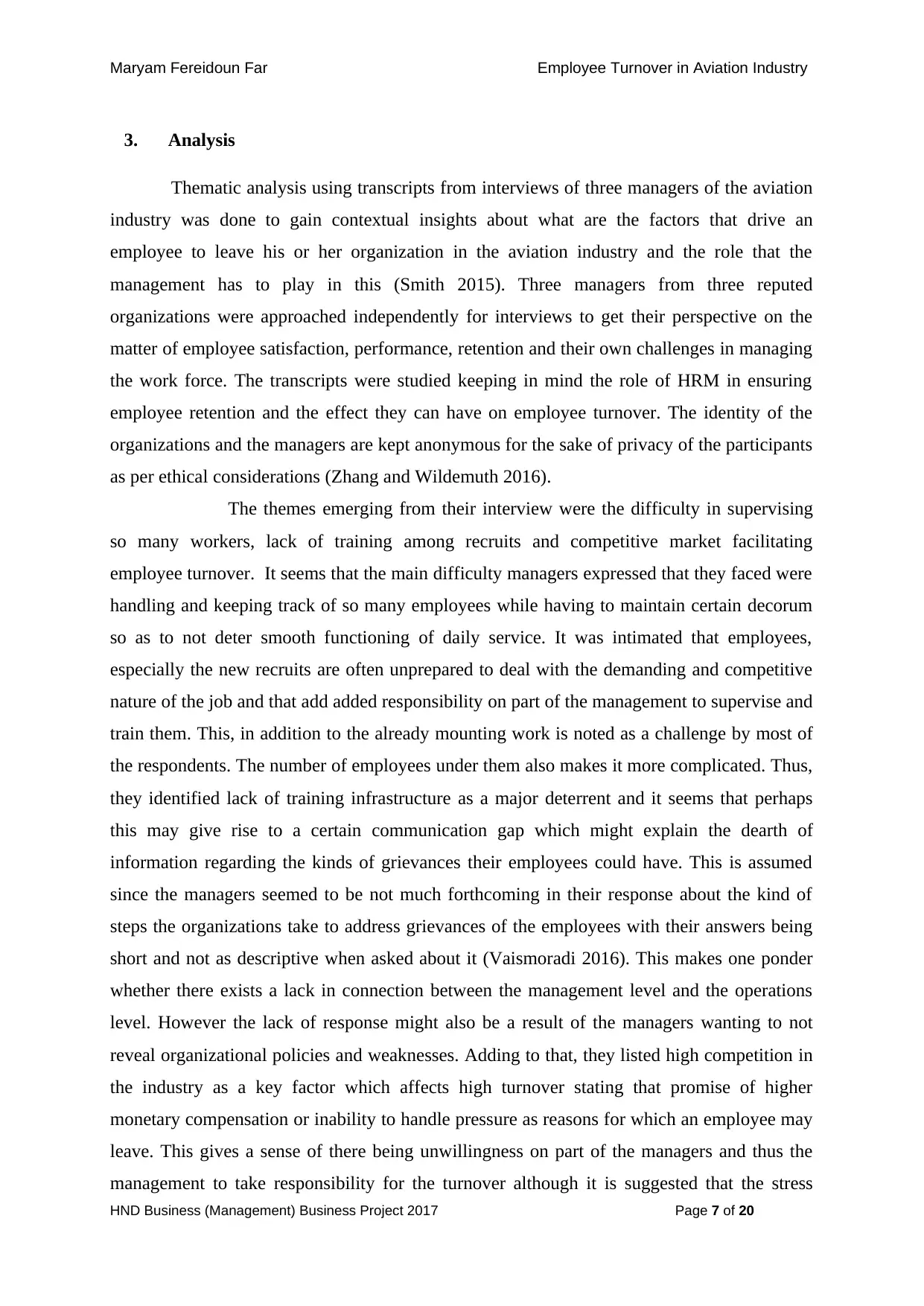
Maryam Fereidoun Far Employee Turnover in Aviation Industry
3. Analysis
Thematic analysis using transcripts from interviews of three managers of the aviation
industry was done to gain contextual insights about what are the factors that drive an
employee to leave his or her organization in the aviation industry and the role that the
management has to play in this (Smith 2015). Three managers from three reputed
organizations were approached independently for interviews to get their perspective on the
matter of employee satisfaction, performance, retention and their own challenges in managing
the work force. The transcripts were studied keeping in mind the role of HRM in ensuring
employee retention and the effect they can have on employee turnover. The identity of the
organizations and the managers are kept anonymous for the sake of privacy of the participants
as per ethical considerations (Zhang and Wildemuth 2016).
The themes emerging from their interview were the difficulty in supervising
so many workers, lack of training among recruits and competitive market facilitating
employee turnover. It seems that the main difficulty managers expressed that they faced were
handling and keeping track of so many employees while having to maintain certain decorum
so as to not deter smooth functioning of daily service. It was intimated that employees,
especially the new recruits are often unprepared to deal with the demanding and competitive
nature of the job and that add added responsibility on part of the management to supervise and
train them. This, in addition to the already mounting work is noted as a challenge by most of
the respondents. The number of employees under them also makes it more complicated. Thus,
they identified lack of training infrastructure as a major deterrent and it seems that perhaps
this may give rise to a certain communication gap which might explain the dearth of
information regarding the kinds of grievances their employees could have. This is assumed
since the managers seemed to be not much forthcoming in their response about the kind of
steps the organizations take to address grievances of the employees with their answers being
short and not as descriptive when asked about it (Vaismoradi 2016). This makes one ponder
whether there exists a lack in connection between the management level and the operations
level. However the lack of response might also be a result of the managers wanting to not
reveal organizational policies and weaknesses. Adding to that, they listed high competition in
the industry as a key factor which affects high turnover stating that promise of higher
monetary compensation or inability to handle pressure as reasons for which an employee may
leave. This gives a sense of there being unwillingness on part of the managers and thus the
management to take responsibility for the turnover although it is suggested that the stress
HND Business (Management) Business Project 2017 Page 7 of 20
3. Analysis
Thematic analysis using transcripts from interviews of three managers of the aviation
industry was done to gain contextual insights about what are the factors that drive an
employee to leave his or her organization in the aviation industry and the role that the
management has to play in this (Smith 2015). Three managers from three reputed
organizations were approached independently for interviews to get their perspective on the
matter of employee satisfaction, performance, retention and their own challenges in managing
the work force. The transcripts were studied keeping in mind the role of HRM in ensuring
employee retention and the effect they can have on employee turnover. The identity of the
organizations and the managers are kept anonymous for the sake of privacy of the participants
as per ethical considerations (Zhang and Wildemuth 2016).
The themes emerging from their interview were the difficulty in supervising
so many workers, lack of training among recruits and competitive market facilitating
employee turnover. It seems that the main difficulty managers expressed that they faced were
handling and keeping track of so many employees while having to maintain certain decorum
so as to not deter smooth functioning of daily service. It was intimated that employees,
especially the new recruits are often unprepared to deal with the demanding and competitive
nature of the job and that add added responsibility on part of the management to supervise and
train them. This, in addition to the already mounting work is noted as a challenge by most of
the respondents. The number of employees under them also makes it more complicated. Thus,
they identified lack of training infrastructure as a major deterrent and it seems that perhaps
this may give rise to a certain communication gap which might explain the dearth of
information regarding the kinds of grievances their employees could have. This is assumed
since the managers seemed to be not much forthcoming in their response about the kind of
steps the organizations take to address grievances of the employees with their answers being
short and not as descriptive when asked about it (Vaismoradi 2016). This makes one ponder
whether there exists a lack in connection between the management level and the operations
level. However the lack of response might also be a result of the managers wanting to not
reveal organizational policies and weaknesses. Adding to that, they listed high competition in
the industry as a key factor which affects high turnover stating that promise of higher
monetary compensation or inability to handle pressure as reasons for which an employee may
leave. This gives a sense of there being unwillingness on part of the managers and thus the
management to take responsibility for the turnover although it is suggested that the stress
HND Business (Management) Business Project 2017 Page 7 of 20
Paraphrase This Document
Need a fresh take? Get an instant paraphrase of this document with our AI Paraphraser
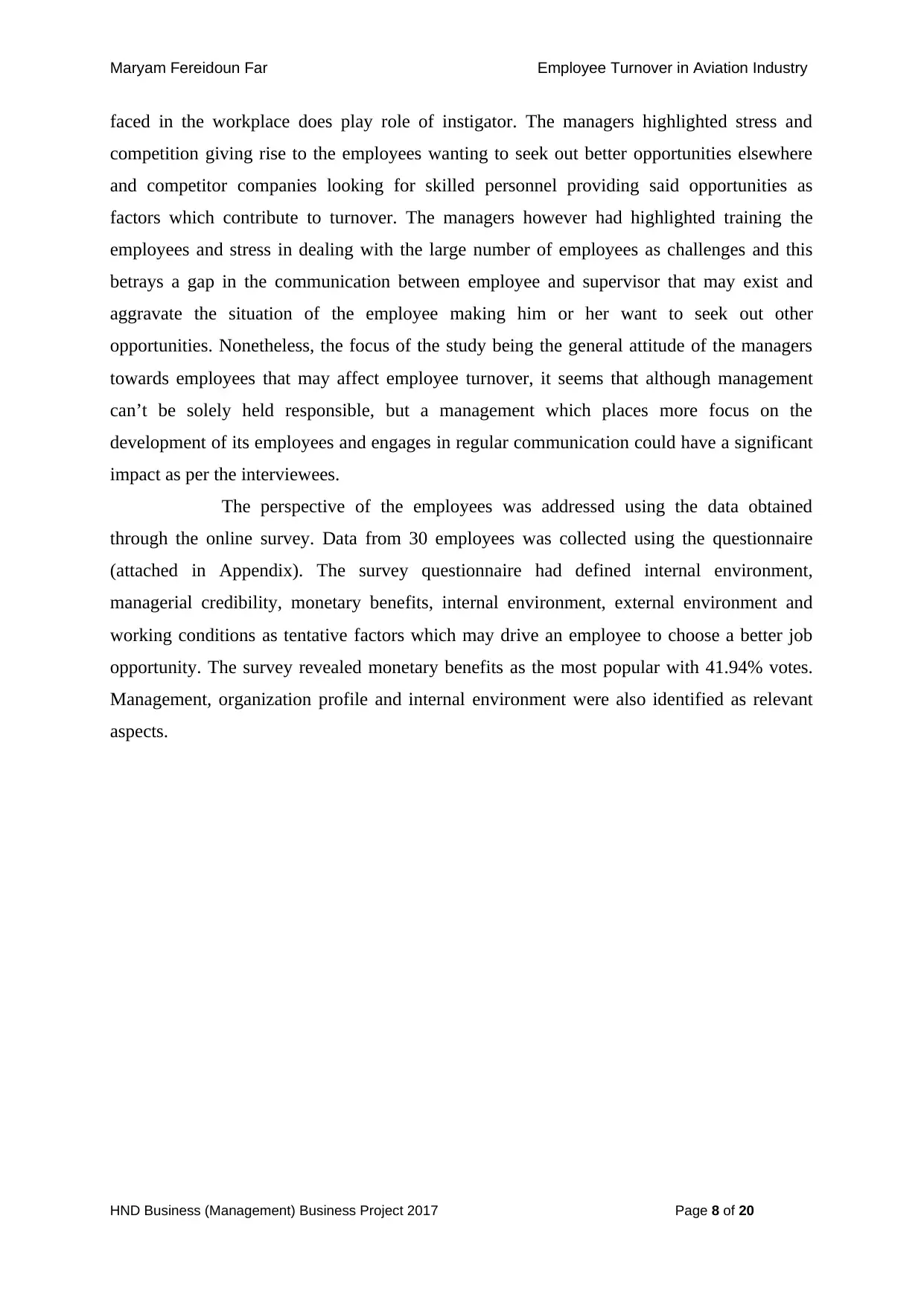
Maryam Fereidoun Far Employee Turnover in Aviation Industry
faced in the workplace does play role of instigator. The managers highlighted stress and
competition giving rise to the employees wanting to seek out better opportunities elsewhere
and competitor companies looking for skilled personnel providing said opportunities as
factors which contribute to turnover. The managers however had highlighted training the
employees and stress in dealing with the large number of employees as challenges and this
betrays a gap in the communication between employee and supervisor that may exist and
aggravate the situation of the employee making him or her want to seek out other
opportunities. Nonetheless, the focus of the study being the general attitude of the managers
towards employees that may affect employee turnover, it seems that although management
can’t be solely held responsible, but a management which places more focus on the
development of its employees and engages in regular communication could have a significant
impact as per the interviewees.
The perspective of the employees was addressed using the data obtained
through the online survey. Data from 30 employees was collected using the questionnaire
(attached in Appendix). The survey questionnaire had defined internal environment,
managerial credibility, monetary benefits, internal environment, external environment and
working conditions as tentative factors which may drive an employee to choose a better job
opportunity. The survey revealed monetary benefits as the most popular with 41.94% votes.
Management, organization profile and internal environment were also identified as relevant
aspects.
HND Business (Management) Business Project 2017 Page 8 of 20
faced in the workplace does play role of instigator. The managers highlighted stress and
competition giving rise to the employees wanting to seek out better opportunities elsewhere
and competitor companies looking for skilled personnel providing said opportunities as
factors which contribute to turnover. The managers however had highlighted training the
employees and stress in dealing with the large number of employees as challenges and this
betrays a gap in the communication between employee and supervisor that may exist and
aggravate the situation of the employee making him or her want to seek out other
opportunities. Nonetheless, the focus of the study being the general attitude of the managers
towards employees that may affect employee turnover, it seems that although management
can’t be solely held responsible, but a management which places more focus on the
development of its employees and engages in regular communication could have a significant
impact as per the interviewees.
The perspective of the employees was addressed using the data obtained
through the online survey. Data from 30 employees was collected using the questionnaire
(attached in Appendix). The survey questionnaire had defined internal environment,
managerial credibility, monetary benefits, internal environment, external environment and
working conditions as tentative factors which may drive an employee to choose a better job
opportunity. The survey revealed monetary benefits as the most popular with 41.94% votes.
Management, organization profile and internal environment were also identified as relevant
aspects.
HND Business (Management) Business Project 2017 Page 8 of 20
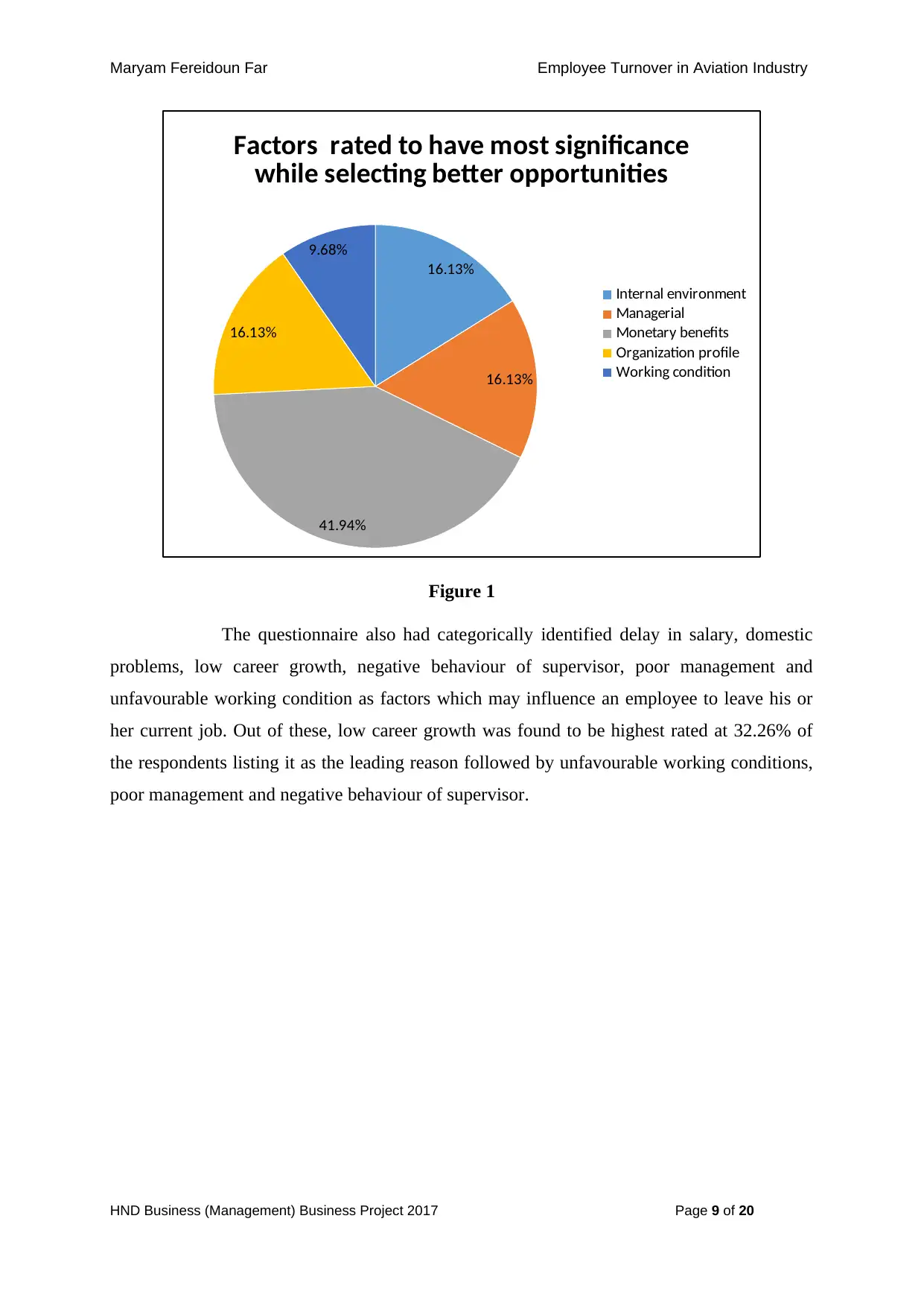
Maryam Fereidoun Far Employee Turnover in Aviation Industry
16.13%
16.13%
41.94%
16.13%
9.68%
Factors rated to have most significance
while selecting better opportunities
Internal environment
Managerial
Monetary benefits
Organization profile
Working condition
Figure 1
The questionnaire also had categorically identified delay in salary, domestic
problems, low career growth, negative behaviour of supervisor, poor management and
unfavourable working condition as factors which may influence an employee to leave his or
her current job. Out of these, low career growth was found to be highest rated at 32.26% of
the respondents listing it as the leading reason followed by unfavourable working conditions,
poor management and negative behaviour of supervisor.
HND Business (Management) Business Project 2017 Page 9 of 20
16.13%
16.13%
41.94%
16.13%
9.68%
Factors rated to have most significance
while selecting better opportunities
Internal environment
Managerial
Monetary benefits
Organization profile
Working condition
Figure 1
The questionnaire also had categorically identified delay in salary, domestic
problems, low career growth, negative behaviour of supervisor, poor management and
unfavourable working condition as factors which may influence an employee to leave his or
her current job. Out of these, low career growth was found to be highest rated at 32.26% of
the respondents listing it as the leading reason followed by unfavourable working conditions,
poor management and negative behaviour of supervisor.
HND Business (Management) Business Project 2017 Page 9 of 20
⊘ This is a preview!⊘
Do you want full access?
Subscribe today to unlock all pages.

Trusted by 1+ million students worldwide
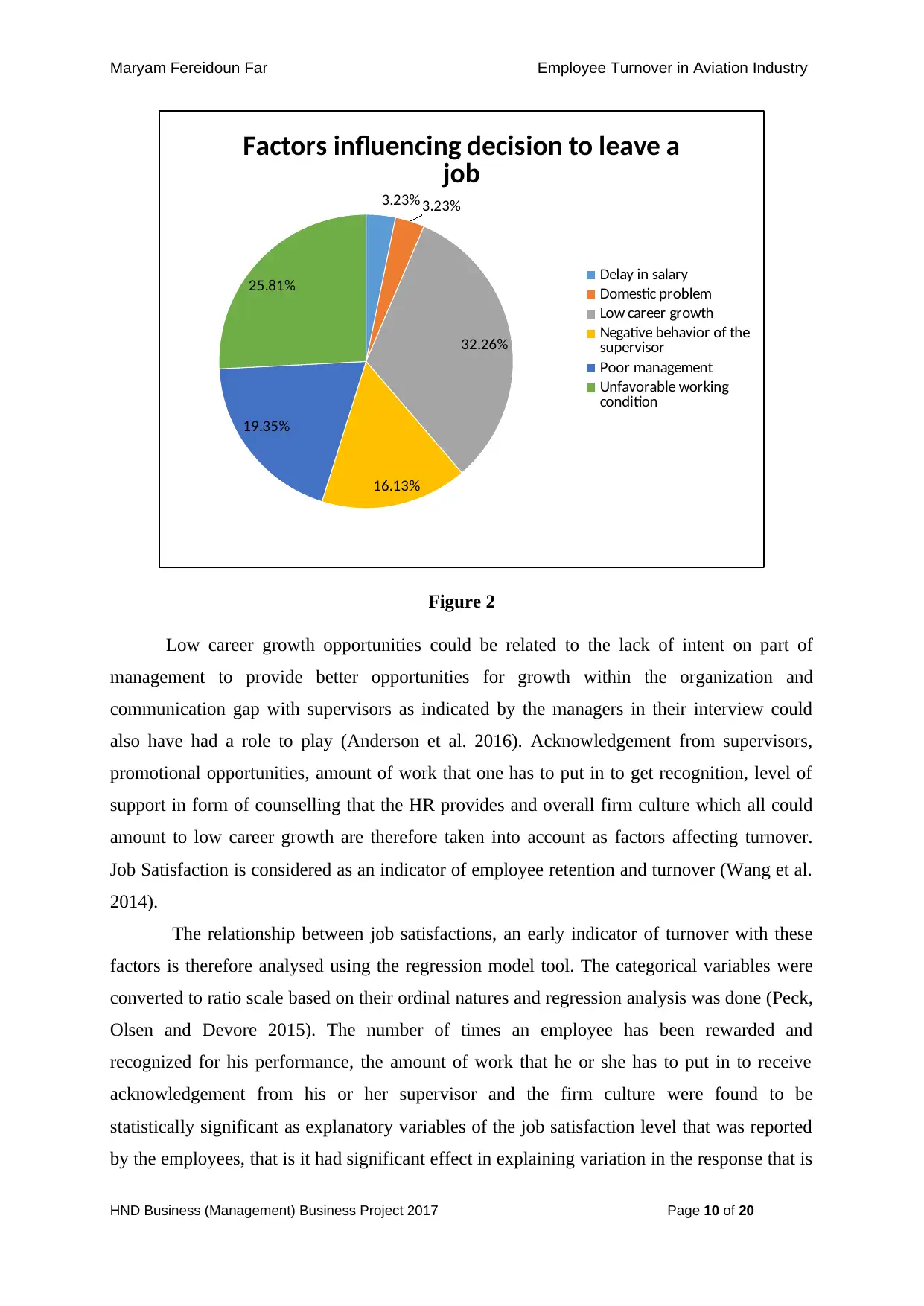
Maryam Fereidoun Far Employee Turnover in Aviation Industry
3.23% 3.23%
32.26%
16.13%
19.35%
25.81%
Factors influencing decision to leave a
job
Delay in salary
Domestic problem
Low career growth
Negative behavior of the
supervisor
Poor management
Unfavorable working
condition
Figure 2
Low career growth opportunities could be related to the lack of intent on part of
management to provide better opportunities for growth within the organization and
communication gap with supervisors as indicated by the managers in their interview could
also have had a role to play (Anderson et al. 2016). Acknowledgement from supervisors,
promotional opportunities, amount of work that one has to put in to get recognition, level of
support in form of counselling that the HR provides and overall firm culture which all could
amount to low career growth are therefore taken into account as factors affecting turnover.
Job Satisfaction is considered as an indicator of employee retention and turnover (Wang et al.
2014).
The relationship between job satisfactions, an early indicator of turnover with these
factors is therefore analysed using the regression model tool. The categorical variables were
converted to ratio scale based on their ordinal natures and regression analysis was done (Peck,
Olsen and Devore 2015). The number of times an employee has been rewarded and
recognized for his performance, the amount of work that he or she has to put in to receive
acknowledgement from his or her supervisor and the firm culture were found to be
statistically significant as explanatory variables of the job satisfaction level that was reported
by the employees, that is it had significant effect in explaining variation in the response that is
HND Business (Management) Business Project 2017 Page 10 of 20
3.23% 3.23%
32.26%
16.13%
19.35%
25.81%
Factors influencing decision to leave a
job
Delay in salary
Domestic problem
Low career growth
Negative behavior of the
supervisor
Poor management
Unfavorable working
condition
Figure 2
Low career growth opportunities could be related to the lack of intent on part of
management to provide better opportunities for growth within the organization and
communication gap with supervisors as indicated by the managers in their interview could
also have had a role to play (Anderson et al. 2016). Acknowledgement from supervisors,
promotional opportunities, amount of work that one has to put in to get recognition, level of
support in form of counselling that the HR provides and overall firm culture which all could
amount to low career growth are therefore taken into account as factors affecting turnover.
Job Satisfaction is considered as an indicator of employee retention and turnover (Wang et al.
2014).
The relationship between job satisfactions, an early indicator of turnover with these
factors is therefore analysed using the regression model tool. The categorical variables were
converted to ratio scale based on their ordinal natures and regression analysis was done (Peck,
Olsen and Devore 2015). The number of times an employee has been rewarded and
recognized for his performance, the amount of work that he or she has to put in to receive
acknowledgement from his or her supervisor and the firm culture were found to be
statistically significant as explanatory variables of the job satisfaction level that was reported
by the employees, that is it had significant effect in explaining variation in the response that is
HND Business (Management) Business Project 2017 Page 10 of 20
Paraphrase This Document
Need a fresh take? Get an instant paraphrase of this document with our AI Paraphraser
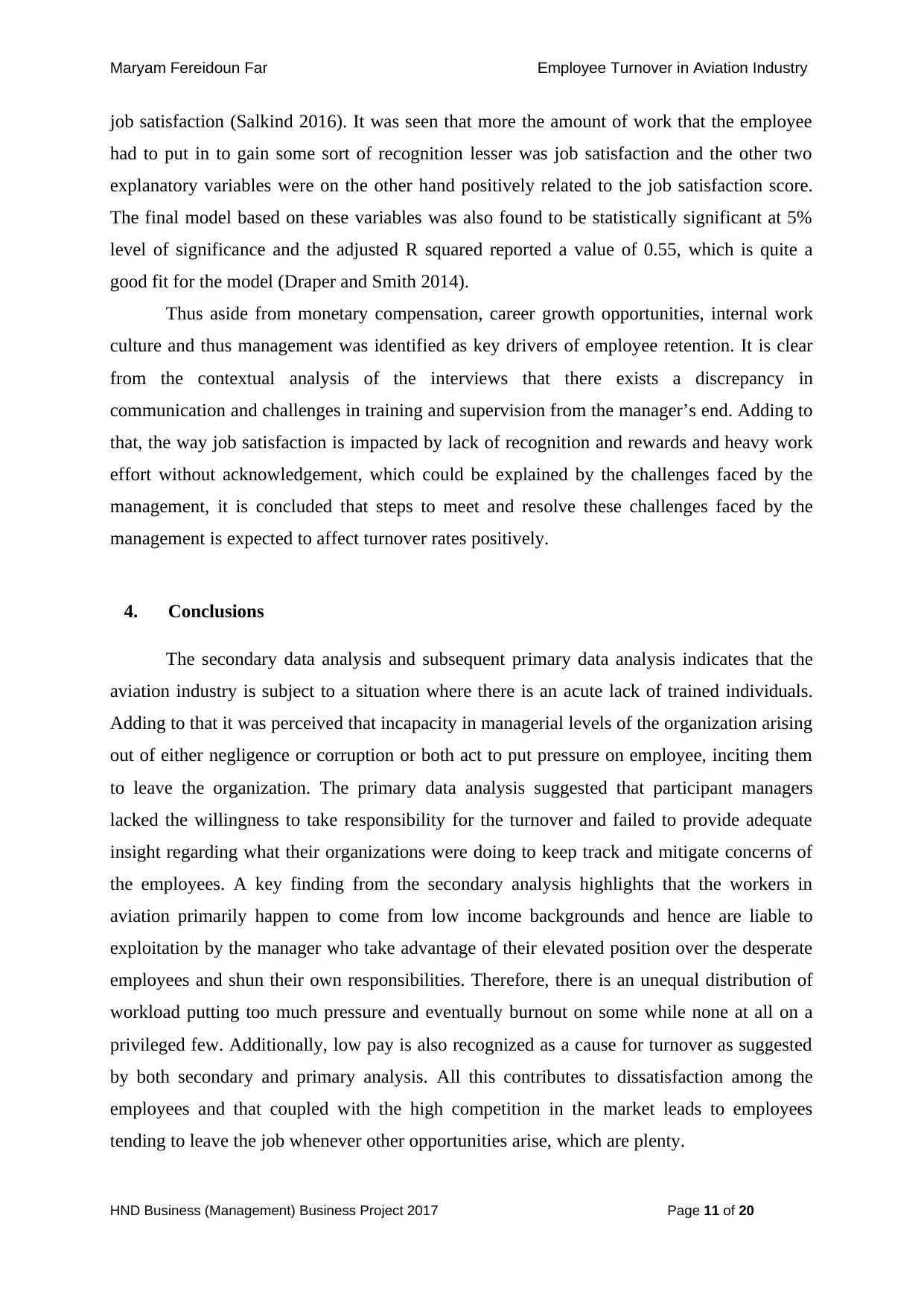
Maryam Fereidoun Far Employee Turnover in Aviation Industry
job satisfaction (Salkind 2016). It was seen that more the amount of work that the employee
had to put in to gain some sort of recognition lesser was job satisfaction and the other two
explanatory variables were on the other hand positively related to the job satisfaction score.
The final model based on these variables was also found to be statistically significant at 5%
level of significance and the adjusted R squared reported a value of 0.55, which is quite a
good fit for the model (Draper and Smith 2014).
Thus aside from monetary compensation, career growth opportunities, internal work
culture and thus management was identified as key drivers of employee retention. It is clear
from the contextual analysis of the interviews that there exists a discrepancy in
communication and challenges in training and supervision from the manager’s end. Adding to
that, the way job satisfaction is impacted by lack of recognition and rewards and heavy work
effort without acknowledgement, which could be explained by the challenges faced by the
management, it is concluded that steps to meet and resolve these challenges faced by the
management is expected to affect turnover rates positively.
4. Conclusions
The secondary data analysis and subsequent primary data analysis indicates that the
aviation industry is subject to a situation where there is an acute lack of trained individuals.
Adding to that it was perceived that incapacity in managerial levels of the organization arising
out of either negligence or corruption or both act to put pressure on employee, inciting them
to leave the organization. The primary data analysis suggested that participant managers
lacked the willingness to take responsibility for the turnover and failed to provide adequate
insight regarding what their organizations were doing to keep track and mitigate concerns of
the employees. A key finding from the secondary analysis highlights that the workers in
aviation primarily happen to come from low income backgrounds and hence are liable to
exploitation by the manager who take advantage of their elevated position over the desperate
employees and shun their own responsibilities. Therefore, there is an unequal distribution of
workload putting too much pressure and eventually burnout on some while none at all on a
privileged few. Additionally, low pay is also recognized as a cause for turnover as suggested
by both secondary and primary analysis. All this contributes to dissatisfaction among the
employees and that coupled with the high competition in the market leads to employees
tending to leave the job whenever other opportunities arise, which are plenty.
HND Business (Management) Business Project 2017 Page 11 of 20
job satisfaction (Salkind 2016). It was seen that more the amount of work that the employee
had to put in to gain some sort of recognition lesser was job satisfaction and the other two
explanatory variables were on the other hand positively related to the job satisfaction score.
The final model based on these variables was also found to be statistically significant at 5%
level of significance and the adjusted R squared reported a value of 0.55, which is quite a
good fit for the model (Draper and Smith 2014).
Thus aside from monetary compensation, career growth opportunities, internal work
culture and thus management was identified as key drivers of employee retention. It is clear
from the contextual analysis of the interviews that there exists a discrepancy in
communication and challenges in training and supervision from the manager’s end. Adding to
that, the way job satisfaction is impacted by lack of recognition and rewards and heavy work
effort without acknowledgement, which could be explained by the challenges faced by the
management, it is concluded that steps to meet and resolve these challenges faced by the
management is expected to affect turnover rates positively.
4. Conclusions
The secondary data analysis and subsequent primary data analysis indicates that the
aviation industry is subject to a situation where there is an acute lack of trained individuals.
Adding to that it was perceived that incapacity in managerial levels of the organization arising
out of either negligence or corruption or both act to put pressure on employee, inciting them
to leave the organization. The primary data analysis suggested that participant managers
lacked the willingness to take responsibility for the turnover and failed to provide adequate
insight regarding what their organizations were doing to keep track and mitigate concerns of
the employees. A key finding from the secondary analysis highlights that the workers in
aviation primarily happen to come from low income backgrounds and hence are liable to
exploitation by the manager who take advantage of their elevated position over the desperate
employees and shun their own responsibilities. Therefore, there is an unequal distribution of
workload putting too much pressure and eventually burnout on some while none at all on a
privileged few. Additionally, low pay is also recognized as a cause for turnover as suggested
by both secondary and primary analysis. All this contributes to dissatisfaction among the
employees and that coupled with the high competition in the market leads to employees
tending to leave the job whenever other opportunities arise, which are plenty.
HND Business (Management) Business Project 2017 Page 11 of 20
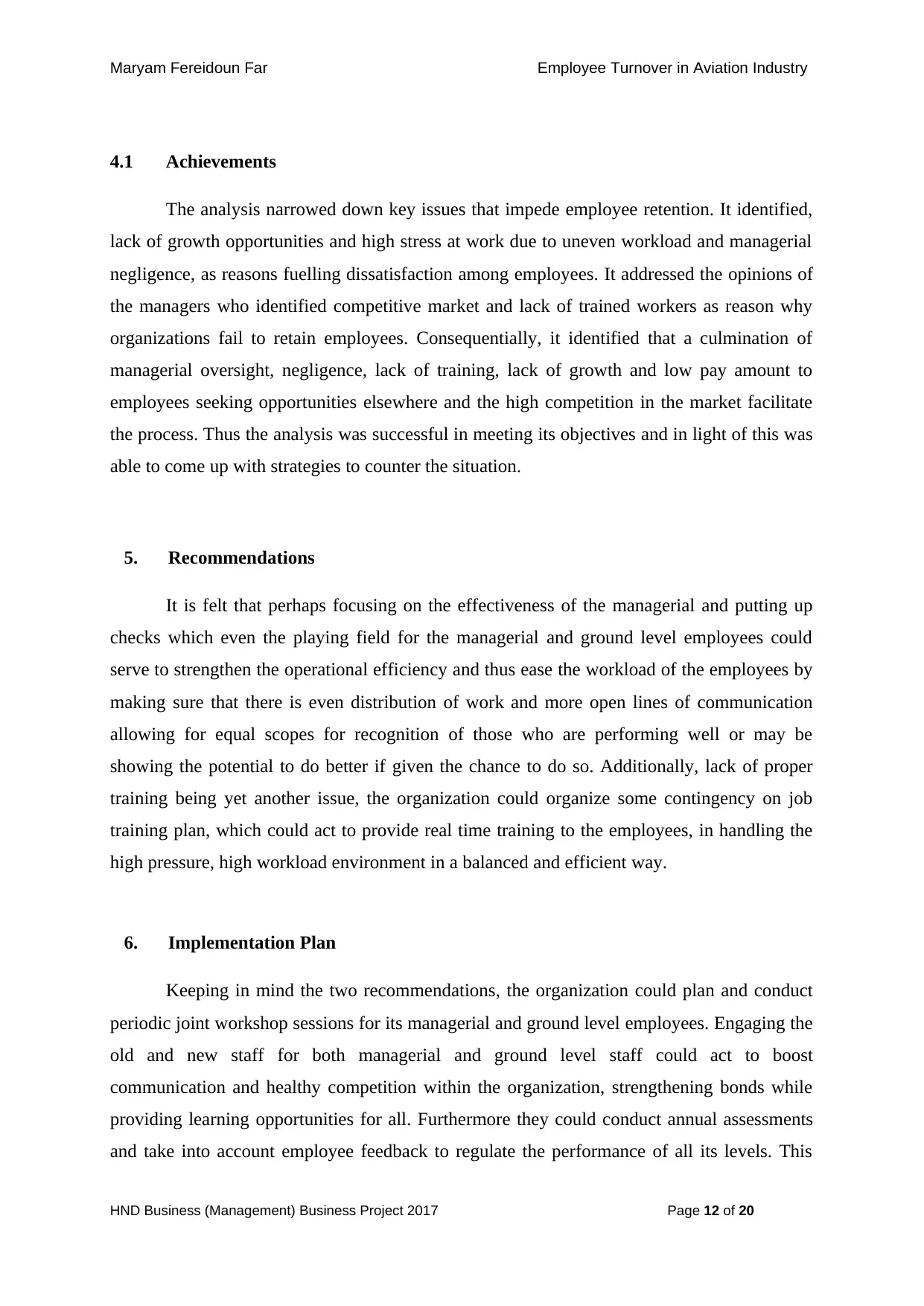
Maryam Fereidoun Far Employee Turnover in Aviation Industry
4.1 Achievements
The analysis narrowed down key issues that impede employee retention. It identified,
lack of growth opportunities and high stress at work due to uneven workload and managerial
negligence, as reasons fuelling dissatisfaction among employees. It addressed the opinions of
the managers who identified competitive market and lack of trained workers as reason why
organizations fail to retain employees. Consequentially, it identified that a culmination of
managerial oversight, negligence, lack of training, lack of growth and low pay amount to
employees seeking opportunities elsewhere and the high competition in the market facilitate
the process. Thus the analysis was successful in meeting its objectives and in light of this was
able to come up with strategies to counter the situation.
5. Recommendations
It is felt that perhaps focusing on the effectiveness of the managerial and putting up
checks which even the playing field for the managerial and ground level employees could
serve to strengthen the operational efficiency and thus ease the workload of the employees by
making sure that there is even distribution of work and more open lines of communication
allowing for equal scopes for recognition of those who are performing well or may be
showing the potential to do better if given the chance to do so. Additionally, lack of proper
training being yet another issue, the organization could organize some contingency on job
training plan, which could act to provide real time training to the employees, in handling the
high pressure, high workload environment in a balanced and efficient way.
6. Implementation Plan
Keeping in mind the two recommendations, the organization could plan and conduct
periodic joint workshop sessions for its managerial and ground level employees. Engaging the
old and new staff for both managerial and ground level staff could act to boost
communication and healthy competition within the organization, strengthening bonds while
providing learning opportunities for all. Furthermore they could conduct annual assessments
and take into account employee feedback to regulate the performance of all its levels. This
HND Business (Management) Business Project 2017 Page 12 of 20
4.1 Achievements
The analysis narrowed down key issues that impede employee retention. It identified,
lack of growth opportunities and high stress at work due to uneven workload and managerial
negligence, as reasons fuelling dissatisfaction among employees. It addressed the opinions of
the managers who identified competitive market and lack of trained workers as reason why
organizations fail to retain employees. Consequentially, it identified that a culmination of
managerial oversight, negligence, lack of training, lack of growth and low pay amount to
employees seeking opportunities elsewhere and the high competition in the market facilitate
the process. Thus the analysis was successful in meeting its objectives and in light of this was
able to come up with strategies to counter the situation.
5. Recommendations
It is felt that perhaps focusing on the effectiveness of the managerial and putting up
checks which even the playing field for the managerial and ground level employees could
serve to strengthen the operational efficiency and thus ease the workload of the employees by
making sure that there is even distribution of work and more open lines of communication
allowing for equal scopes for recognition of those who are performing well or may be
showing the potential to do better if given the chance to do so. Additionally, lack of proper
training being yet another issue, the organization could organize some contingency on job
training plan, which could act to provide real time training to the employees, in handling the
high pressure, high workload environment in a balanced and efficient way.
6. Implementation Plan
Keeping in mind the two recommendations, the organization could plan and conduct
periodic joint workshop sessions for its managerial and ground level employees. Engaging the
old and new staff for both managerial and ground level staff could act to boost
communication and healthy competition within the organization, strengthening bonds while
providing learning opportunities for all. Furthermore they could conduct annual assessments
and take into account employee feedback to regulate the performance of all its levels. This
HND Business (Management) Business Project 2017 Page 12 of 20
⊘ This is a preview!⊘
Do you want full access?
Subscribe today to unlock all pages.

Trusted by 1+ million students worldwide
1 out of 20
Related Documents
Your All-in-One AI-Powered Toolkit for Academic Success.
+13062052269
info@desklib.com
Available 24*7 on WhatsApp / Email
![[object Object]](/_next/static/media/star-bottom.7253800d.svg)
Unlock your academic potential
Copyright © 2020–2025 A2Z Services. All Rights Reserved. Developed and managed by ZUCOL.





